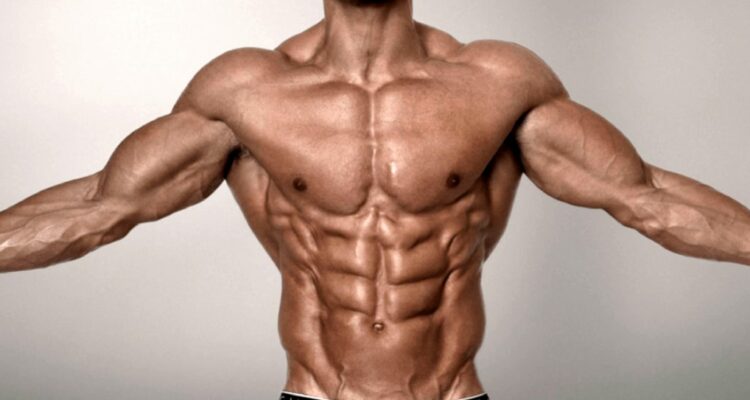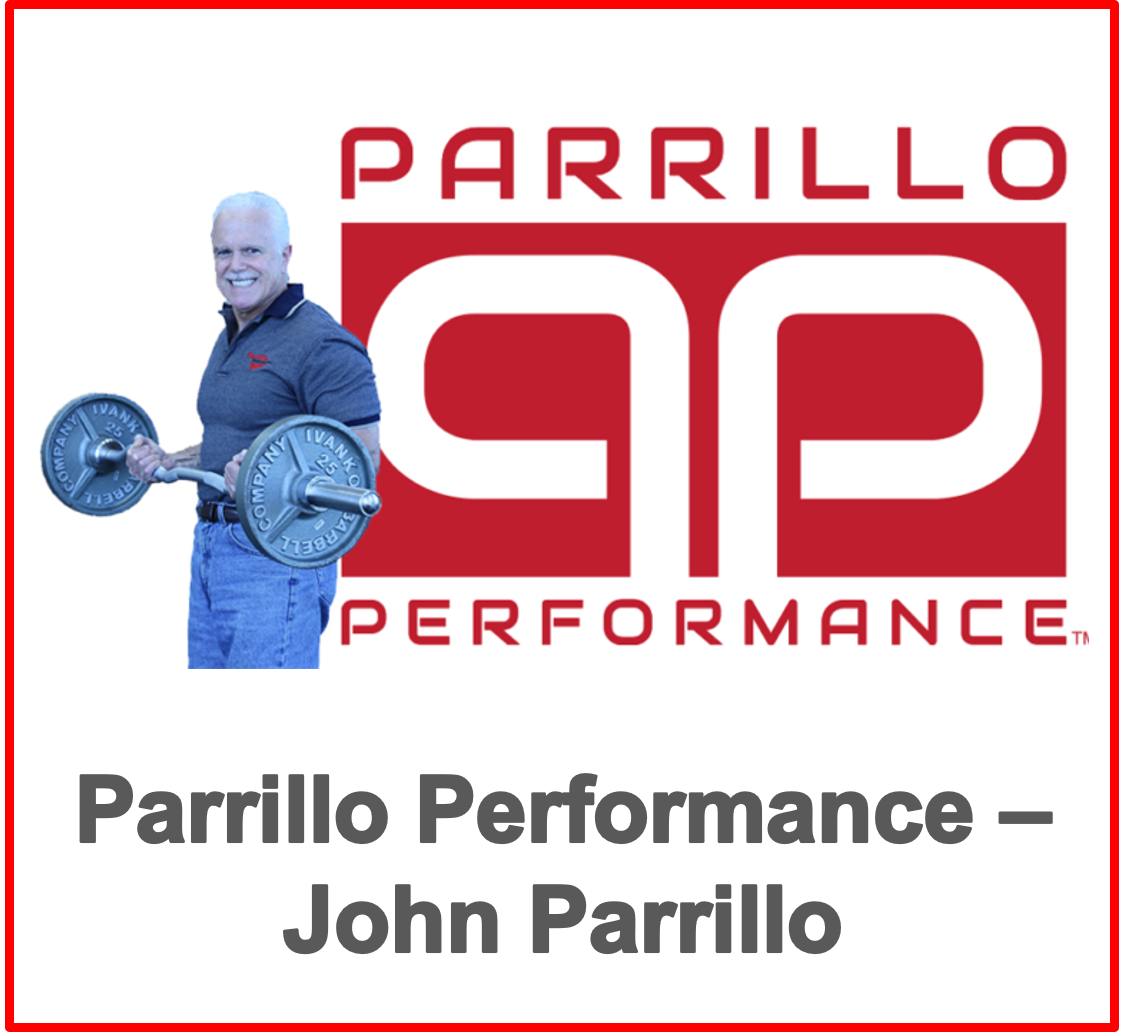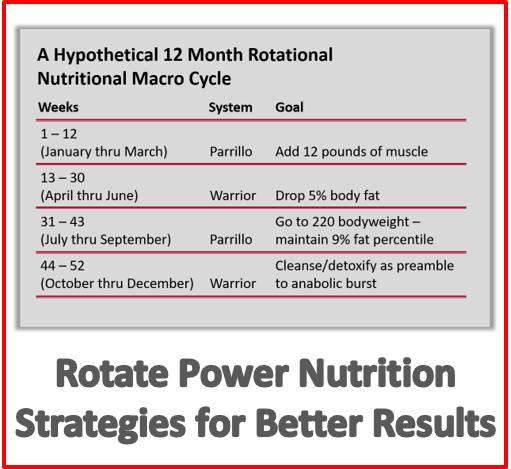Anabolism is a good thing. Metabolically speaking, when a person is anabolic, muscle growth is possible. Anabolism is such a good thing that medical people invented anabolic steroids as a way to artificially induce anabolism. Elite athletes and cutting-edge coaches understand that by creating an anabolic environment and then subjecting the anabolic individual to a high intensity weight workout, new muscle is constructed. The natural way to establish anabolism is to consume a lot of calories. The way to create anabolism - and not add body fat - is to obtain those calories from quality food sources.
It is easy to establish anabolism: eat lots of calories from indiscriminate food sources. Fat calories pack a wallop: 9 calories per gram. Protein and carbohydrate deliver 4 calories per gram. Eat a lot of fat calories and establish anabolism quicker that you can say, "Pass the Prime Rib." To grow muscle and not add adipose tissue during the growth process requires discrimination and restraint. Athletes that overeat not only induce anabolism and grow muscle they also construct new fat cells. Excessive calories not used for the production of muscle tissue or used for energy (or passed through the digestive system and excreted) are converted into fat and stored away for future use. Optimally, the person intent on establishing an anabolic toehold will consume enough calories to trigger anabolism - yet not consume an excessive amount of calories as excess is shuttled to bodily fat storage depots.
How do you know when you've tipped the energy balance equation to the plus side and established anabolism?
How do you know when to stop taking in calories?
The answer is best arrived at by approaching the problem from a different direction. Train like hell and afterwards consume an ample amount of beneficial foods. Avoid detrimental foods altogether. That would make for a superb start. Do this for a week. Fine tuning can occur when we do things on a regularly reoccurring basis. Certain foods are extremely difficult for the human body to convert into body fat - not impossible, but damned difficult. By consuming calories derived from these foods, the anabolic margin of error is dramatically increased. Lean protein, protein with a minimal saturated fat, has been the staple bedrock nutrient of elite athletes for 50 years. Why? You can eat a mountain of lean protein and not add to fat storage - assuming you train with intensity sufficient enough o trigger hypertrophy. Lean protein is difficult for the body to digest. As a direct result, the body kicks the metabolic thermostat upward to break protein down into subcomponent amino acids. Both Keto and Paleo recommended food lists provide a good starting point of quality nutrients. See lists below.
Ketogenic Diet Recommended Foods
Do Eat
Do Not Eat
Paleo Diet Recommended Foods
Do Eat
Do Not Eat
We us the thermic effect of food to goose the metabolism. We use intense weight training to goose the metabolism. We use hard cardio to goose the metabolism. After a few weeks of continually goosing the metabolism it stays goosed - permanently amped up: you have successfully reset the metabolic thermostat upward. Quite an amazing feat, actually.
When a healthy, rested muscle operating in the fertile field of Positive Nitrogen Balance is suddenly subjected to a high intensity weight workout (then fed and rested) that muscle grows larger and grows stronger. The muscle must be adequately stressed to induce growth, stressed to such a degree that the adaptive response is triggered. The adaptive response occurs when the athlete trains with a training intensity sufficient to trip the hypertrophy switch.
Muscle tissue needs to be fed to stay alive. If you shatter a muscle in training then stave that muscle, the muscle shrinks and weakens. Instead of the wonder of anabolism, catabolism takes root. Catabolism (simplistically speaking) is muscular cannibalism. During catabolism the body can eat its own muscle tissue for fuel. When catabolism takes root the body will strip the amino acid content off muscle walls to fuel caloric shortfall. This in an attempt to ward off perceived starvation. The human body seeks to preserve stored body fat at all costs. Stored fat is like money in a savings account. The body views stored fat as the last line of defense against starvation. If overworked and under-fed, the body will preferentially eat muscle tissue to save its precious body fat. Too much training and not enough food produces the catabolic horror of self-inflicted muscular cannibalism. Slash calories for a protracted period and trigger a metabolic freefall.
Obese individuals that engage in crash diets and precipitously slash calories always end up as miniaturized versions of their old fat selves. They might lose 100 pounds of body weight yet still appear fat.
Why? Because they are still fat!
Despite reducing their weight from say 350 pounds to 250 pounds, the body has cannibalized as much or more muscle tissue than body fat during the reduction process. Though the individual might weight 100 pounds less, they still might possess a 40% body fat percentile. Obese individuals that choose to starve the weight off lose unacceptable amounts of muscle mass (not that they had any to spare to begin with) during the weight loss process.
How do you avoid the metabolic shutdown associated with crash dieting?
Don't crash diet!
Choose the right fuel sources. Never starve yourself. Use a slow downward glide-path when whittling off body fat. The Basal Metabolic Rate (BMR) is "the amount of energy expended while at rest in a neutrally temperate environment." The BMR is the metabolic thermostat and denotes the rate at which our body consumes calories while at rest. Digestion of certain, hard to digest nutrients naturally elevates the BMR. See below.
Protein is difficult to break down. Amino acids are needed to heal, recover, repair and construct new muscle tissue. Protein is the bedrock nutrient in the physical renovation process. It feeds muscle tissue battered by high intensity weigh workouts and extended cardio sessions. Purposeful Primitives need protein and lots of it.
Fibrous carbohydrates - carrots, broccoli, green beans, bell peppers, spinach, cauliflower, onions, asparagus, cabbage, salad greens, brussel sprouts and the like are nearly impossible for the body to convert into body fat. Certain fibrous carbs require almost as many calories to digest as they contain. A green bean or baby carrot might contain 10 calories and the body will expend nearly that much energy to break down and digest these rugged vegetables. Fiber is critical!
Protein and fiber are the central foods in the Purposefully Primitive Performance eating approach. Elite athletes make protein and fiber the foundational backbone of their nutritional regimen.
So should you!
Fibrous carbohydrates have a wonderful roto-rooter effect on the body's internal plumbing. As fiber carbs work their way through the digestive passageways, mucus and gunk is scraped off intestinal walls and sludge buildup is kept to a minimum. For this reason fibrous carbohydrates are the perfect complement to a diet rich in protein. Fiber is the Yin to protein's Yang. Both protein and fiber have beneficial dampening effect on insulin secretions. It is no accident that competitive bodybuilders, the world's best dieters, men capable of reducing body fat percentiles to 2% while maintaining incredible amounts of muscle mass, construct their eating regimen around the copious consumption of protein and fiber.
The goal of the bodybuilder in the weeks leading up to a competition is to melt off as much excess body fat as possible while maintaining the mountainous amount of muscle built up in the off-season. In their pre-competition phase a professional bodybuilder will consume lots of protein, lots of fiber and a wee bit of starchy carbohydrate. A 3,500 calorie pre-contest daily meal schedule might be broken down into five 700 calorie feedings spaced two hours apart ... or perhaps seven 500 calorie meals. The competitive bodybuilder eliminates all food sources that contain calories easily converted into body fat. Refined carbohydrates,, sugar, alcohol, etc are tossed when the pre-competition process commences. Saturate fat intake is kept to a minimum. Optimally smaller meals of relatively equal size, comprised exclusively of foods hard to convert into body fat, are eaten at specified times. By eating every two to three hours, the bodybuilder refuels in about the time the nutrients from the previous meal have been expended.
Every time the bodybuilder eats a protein/fiber mini-meal they elevate their metabolism and reestablish anabolism. These mini-meals give the body lots of practice at assimilating and distributing quality nutrients. Increases in body heat associated with food digestion create a phenomenon known as thermogenesis. The metabolism gears up to digest hard-to-digest nutrients creating a thermic effect. Meals are used to spike the metabolism. A competitive bodybuilder deep into contest prep has their metabolism jacked up to such a degree that they will break out in a sweat as they consume a meal. The introduction of calories causes a dramatic increase in the bodybuilder's body heat.
At the other extreme the crash dieter has succeeded in lowering their metabolic set-point. The calories slasher always feels hungry, deprived, listless and lacking in energy. Calorie slashing sabotages the metabolism, causing it to nosedive. Once the metabolism is shattered, the body goes into starvation mode and resorts to catabolic cannibalism.
Heed this dietary pitfall.
Eat more to lose fat!
Two of our nutritional mentors are John Parrillo (multiple mini-meal schedule) and Ori Hofmekler (The Warrior Diet). Rotating these strategies is a great way to stoke and amp the metabolism. Below are links to Functional Strength articles on both men and their strategies.
Want to learn more about nutritional tips and tactics check out our Nutritional Planning Resource page. Join the community sign up below to our newsletter and receive our FREE Planning and Periodization Guide. Please feel free to send us a question here or leave a comment below.
Want the inside training scoop?
Join The Community
Our email content is full of value, void of hype, never pushy, and always free. As a BONUS you will receive our FREE planning & periodization template to help you with your training goals.




